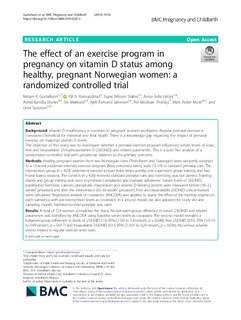| dc.contributor.author | Gustafsson, Miriam K. | |
| dc.contributor.author | Romundstad, Pål Richard | |
| dc.contributor.author | Stafne, Signe Nilssen | |
| dc.contributor.author | Helvik, Anne-Sofie | |
| dc.contributor.author | Stunes, Astrid Kamilla | |
| dc.contributor.author | Mørkved, Siv | |
| dc.contributor.author | Salvesen, Kjell Å | |
| dc.contributor.author | Thorsby, Per Medbøe | |
| dc.contributor.author | Mosti, Mats Peder | |
| dc.contributor.author | Syversen, Unni | |
| dc.date.accessioned | 2019-09-25T06:47:04Z | |
| dc.date.available | 2019-09-25T06:47:04Z | |
| dc.date.created | 2019-06-10T18:02:31Z | |
| dc.date.issued | 2019 | |
| dc.identifier.citation | BMC Pregnancy and Childbirth. 2019, 19:76 1-10. | nb_NO |
| dc.identifier.issn | 1471-2393 | |
| dc.identifier.uri | http://hdl.handle.net/11250/2618607 | |
| dc.description.abstract | Background
Vitamin D insufficiency is common in pregnant women worldwide. Regular prenatal exercise is considered beneficial for maternal and fetal health. There is a knowledge gap regarding the impact of prenatal exercise on maternal vitamin D levels.
The objective of this study was to investigate whether a prenatal exercise program influenced serum levels of total, free and bioavailable 25-hydroxyvitamin D (25(OH)D) and related parameters. This is a post hoc analysis of a randomized controlled trial with gestational diabetes as the primary outcome.
Methods
Healthy, pregnant women from two Norwegian cities (Trondheim and Stavanger) were randomly assigned to a 12-week moderate-intensity exercise program (Borg perceived rating scale 13–14) or standard prenatal care. The intervention group (n = 429) underwent exercise at least three times weekly; one supervised group training and two home based sessions. The controls (n = 426) received standard prenatal care, and exercising was not denied. Training diaries and group training was used to promote compliance and evaluate adherence. Serum levels of 25(OH)D, parathyroid hormone, calcium, phosphate, magnesium and vitamin D-binding protein were measured before (18–22 weeks′ gestation) and after the intervention (32–36 weeks′ gestation). Free and bioavailable 25(OH)D concentrations were calculated. Regression analysis of covariance (ANCOVA) was applied to assess the effect of the training regime on each substance with pre-intervention levels as covariates. In a second model, we also adjusted for study site and sampling month. Intention-to-treat principle was used.
Results
A total of 724 women completed the study. No between-group difference in serum 25(OH)D and related parameters was identified by ANCOVA using baseline serum levels as covariates. The second model revealed a between-group difference in levels of 25(OH)D (1.9, 95% CI 0.0 to 3.8 nmol/L; p = 0.048), free 25(OH)D (0.55, 95% CI 0.10 to 0.99 pmol/L; p = 0.017) and bioavailable 25(OH)D (0.15 95% CI 0.01 to 0.29 nmol/L; p = 0.036). No serious adverse events related to regular exercise were seen.
Conclusion
This study, a post hoc analysis, indicates that exercise may affect vitamin D status positively, and emphasizes that women with uncomplicated pregnancies should be encouraged to perform regular exercise. | nb_NO |
| dc.language.iso | eng | nb_NO |
| dc.publisher | BioMed Central | nb_NO |
| dc.rights | Navngivelse 4.0 Internasjonal | * |
| dc.rights.uri | http://creativecommons.org/licenses/by/4.0/deed.no | * |
| dc.title | The effect of an exercise program in pregnancy on vitamin D status among healthy, pregnant Norwegian women: a randomized controlled trial | nb_NO |
| dc.type | Journal article | nb_NO |
| dc.type | Peer reviewed | nb_NO |
| dc.description.version | publishedVersion | nb_NO |
| dc.source.pagenumber | 1-10 | nb_NO |
| dc.source.volume | 19:76 | nb_NO |
| dc.source.journal | BMC Pregnancy and Childbirth | nb_NO |
| dc.identifier.doi | 10.1186/s12884-019-2220-z | |
| dc.identifier.cristin | 1703769 | |
| dc.description.localcode | Open Access This article is distributed under the terms of the Creative Commons Attribution 4.0 International License (http://creativecommons.org/licenses/by/4.0/), which permits unrestricted use, distribution, and reproduction in any medium, provided you give appropriate credit to the original author(s) and the source, provide a link to the Creative Commons license, and indicate if changes were made. | nb_NO |
| cristin.unitcode | 194,65,20,0 | |
| cristin.unitcode | 1920,24,0,0 | |
| cristin.unitcode | 1920,7,0,0 | |
| cristin.unitcode | 1920,11,0,0 | |
| cristin.unitcode | 1920,0,0,0 | |
| cristin.unitcode | 194,65,15,0 | |
| cristin.unitcode | 1920,13,0,0 | |
| cristin.unitcode | 1920,15,0,0 | |
| cristin.unitname | Institutt for samfunnsmedisin og sykepleie | |
| cristin.unitname | PH - Tiller distriktspsykiatriske senter | |
| cristin.unitname | Klinikk for kliniske servicefunksjoner | |
| cristin.unitname | Klinikk for ØNH, kjeve- og øyesykdommer | |
| cristin.unitname | St. Olavs Hospital HF | |
| cristin.unitname | Institutt for klinisk og molekylær medisin | |
| cristin.unitname | Kvinneklinikken | |
| cristin.unitname | Medisinsk klinikk | |
| cristin.ispublished | true | |
| cristin.fulltext | original | |
| cristin.qualitycode | 1 | |

